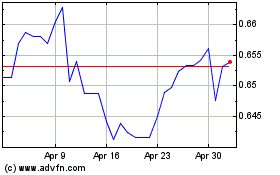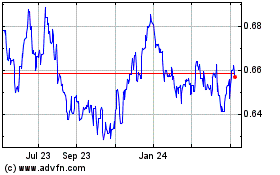Australian Dollar Rises Further After RBA Policy Statement
August 04 2015 - 1:42AM
RTTF2

The Australian dollar rose further against the other major
currencies in the late Asian session on Tuesday after the Reserve
Bank of Australia maintained its key interest rate at a record low,
as widely expected by economists.
The policy board governed by Glenn Stevens decided to leave the
cash rate at 2.00 percent. The bank lowered the rates by 25 basis
points each in February and May.
The board judged that leaving the cash rate unchanged was
appropriate at this meeting.
"Further information on economic and financial conditions to be
received over the period ahead will inform the Board's ongoing
assessment of the outlook and hence whether the current stance of
policy will most effectively foster sustainable growth and
inflation consistent with the target," the bank said in a
statement.
The currency rose earlier following the release of better than
expected trade and retail sales data for June.
Data from the Australian Bureau of Statistics showed that
Australia posted a seasonally adjusted merchandise trade deficit of
A$2.933 billion in June, expanding 10 percent on month. That was
smaller than the A$3.00 billion shortfall expected by economists
and follows the upwardly revised A$2.677 billion deficit in
May.
Exports were up A$830 million or 3.0 percent on month to
A$26.348 billion. While, imports climbed A$1.086 billion or 4.0
percent to A$29.281 billion.
Also, the ABS said that the total value of retail sales in
Australia was up a seasonally adjusted 0.7 percent on month in
June, coming in at A$24.346 billion. That beat forecasts for an
increase of 0.4 percent, which would have been unchanged from the
May reading following an upward revision from 0.3 percent.
Meanwhile, Australia's stock market traded higher. The benchmark
S&P/ASX 200 index is currently up 25.60 points or 0.45 percent
at 5,705. The broader All Ordinaries index is also currently up
41.60 points or 0.73 percent at 5,705.
Monday, the Australian dollar showed mixed trading against its
major rivals. While the aussie rose against the New Zealand and the
Canadian dollars, it held steady against the US dollar, the yen and
the euro.
In the late Asian trading now, the Australian dollar rose to a
2-month high of 0.9676 against the Canadian dollar, from an early
low of 0.9562. The aussie may test resistance near the 0.97
region.
Against the yen, the euro and the NZ dollar, the aussie advanced
to near 2-week highs of 91.18, 1.4879 and 1.1202 from early lows of
90.04, 1.5066 and 1.1066, respectively. If the aussie extends its
uptrend, it is likely to find resistance around 93.00 against the
yen, 1.46 against the euro and 1.13 against the kiwi.
The aussie climbed to a 4-day high of 0.7353 against the U.S.
dollar, from an early low of 0.7262. On the upside, 0.75 is seen as
the next resistance level for the aussie.
Looking ahead, U.K. Markit/CIPS construction PMI for July and
Eurozone PPI for June are due to be released in the European
session.
In the New York session, U.S. factory orders for June and Canada
manufacturing PMI for July are slated for release.
AUD vs US Dollar (FX:AUDUSD)
Forex Chart
From Mar 2024 to Apr 2024

AUD vs US Dollar (FX:AUDUSD)
Forex Chart
From Apr 2023 to Apr 2024
